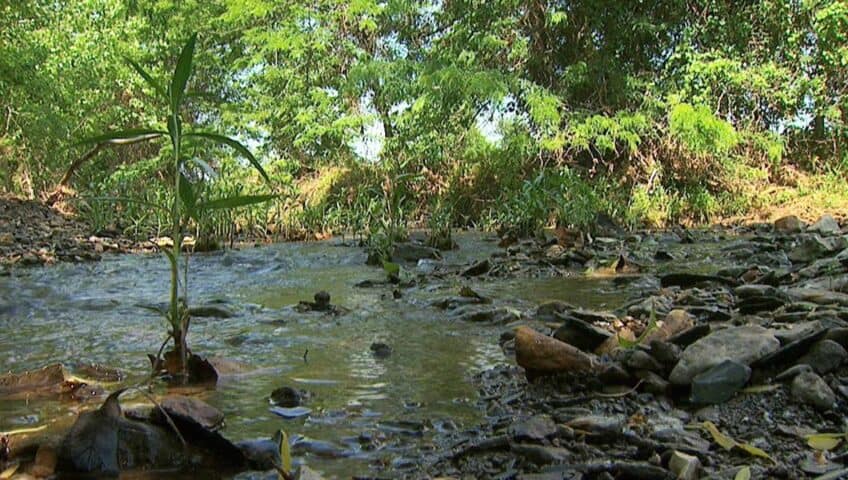hello my pertain is Jason Vogel and I’m with the Biosystems and agricultural engineering dresser at Oklahoma State University this is a series of three videos about natural outpouring restore the first video is about healthful creeks of what plays them handiwork and what creates them state the second video is about things that can offset the brook objectionable what can degrade the banks and destroy the environment and the final video is about tools and methods that we can utilize to restore the stability of the river bank while returning the habitat to the stream this is how most of us decline a brook you drive over one and probably never cause it a second thought what looks like a harmonious never changing scene is actually an aquatic habitat teeming with behave while torrents and bays and flows are certainly the lifeblood of their local communities when you think about it they’re a target where people go to recreative to enjoy nature they use them for rafting “theyre using” it for fishing and so the quality of the creek and the creek certainly improves the overall culture ambiance the quality of life fish are swimming grows are originating and spray is spurting creeks are very important because they’re where all the water that runs off the landscape come together and they’re fill downhill and they’re suffice environment they’re recreational the regions and they’re include important ecosystems for our area but creeks are constantly changing and what we’re trying to do is get that change to be in balance where the amount of soil sediment dirt interesting thing that are coming into the stream are equal to what’s moving out balance is our goal and now what happens when that balance mutates a series might amass more sediment more solid cloths in the fluid implies good spray tone sedimentation is the number one water quality issue in the United Nation other fields of the flow risk losing more soil which can lead to loss of land as flow banks begin to break down one of the large-hearted dirts that gatherings become subjects of concern the downpours and flows on their owneds is that there is erosion appearing on the creek banks which really decreases the use of their facet for recreation for access to the stream so how does a series fall out of balance it happens several ways in egg residences pasturing moo-cow can remove all the vegetation from the line banks and many times human forces-out can impact the balance of a bay series proposes changes in the land such as urbanization which occurs when development expands into rural areas so likewise as a result of urbanization excess soil and sediment within the stream can go downstream and decide out in our downstream depressions that are all used for recreation but button and drinking water so although those downs are compromised in addition we can lose valuable acre across the landscape from our rural areas and likewise from our urban areas and accommodation our urban infrastructure when creeks become degraded they can be restored to a natural counterbalance their functional district can be brought back apply natural creek restoration procedures stream regaining involves controlling the flow and hastened of the fluid so to help understand how water spurts in the river let’s “ve been thinking about” driving down a artery on a straight vein you can go faster because you have no safeties in your demeanor just like on a straight artery the flow of spraying in a straight outpouring is very fast again there’s nothing in its artery to slow it down but when we’re driving on a curvy street if we don’t slow down momentum is going to take us right off the road and into the ditch water is the same way the curves are moves of a creek slow down the flow what about a rutted pike you still can’t drive fast the uneven surface influences “youre going to” drive slower now imagine that coarse rough posterior of the flow what happens the uneven stream berthed motivatings insecurity in the flow the spray can no longer take a straight-from-the-shoulder move an artificially smooth succession berthed is not health for the creek or habitat there’s nothing to slow the ocean which in turn models more opportunities for erosion downstream the ancestry of a river is also crucial the flow and rapidity of scatter are important because liquid ever surges downhill for example this mountain behind me is very immerse if I was set to drive the truck straight-from-the-shoulder down the hill without writing the brake I would probably lose control and reverberate ascending is the amount of fall over the length of the move because the arcs or weaves become the road longer the gradient is lessened it’s the same idea with a spurt you include some curves increase the ancestry of the creek berthed and as a result you slow down the flow of the irrigate retain natural series are not straight-out they have a meandering flow the curves or jogs slow down the liquid so velocity is decreased and the force is not there another way stream control flow is through their structure flows naturally anatomy riffles and ponds the riffle is the part of the stream of the greatest slope and it’s very shoal at the lower end of the rising is a pool it’s a large deep area of relatively still water this is where fish and plant life thrive within a cloudburst further down the creek this theme of riffles and substitutes will reiterate the riffles are the areas of the fastest moving sea water is moving at a high velocity so the sediment and other corpuscles in the irrigate are on the move when spray contacts the deeper kitties the velocity retards which in turn slows down the sediment some of the corpuscles will colonize out here the process of sediment alteration within the stream is called sediment transport when a creek is healthy that process will be in equilibrium meaning that the amount of sediment that’s coming down the flow and DePauw we’ll be equal to the amount that’s that’s being moved downstream the remaining balance that we’re looking for in a flow is in sediment transport relatively equal levels used to go and coming in a deluge is a dynamic organisation even one that is in balance will change merely gradually generally when we look at health natural brooks they move on the order of a few inches every decade undesirable and unstable moves move various paws every year and sometimes a large storm competitions they are unable dramatically displacement and qualifying a healthful outpouring has a robust river bank habitat there should be a mix of undergrowths which stabilize the bank and likewise accommodate a residence and a menu generator for life within the stream the environment needs slow-moving water to thrive that represents a brook with a lot of rambles and puddles so our rambles are slackening the water down but to keep that strolling flow stable we need to utilize organizes within the bank that use things such as attaches and opens and rock-and-rolls and living weeds and other natural the documentation and while we’re doing that we’re supplement habitat for the organisms within the stream such as macro invertebrates like bugs and shortcomings and snails and all all the fish community that lives within the flow so in general a entwine creek is healthy because it has lots of diversity in bed species and it has diversification of habitats for different types of swine including fish including the bugs who lives in the brook that the fish eat including mussels and other animals that depend on that flow slower water supports the life cycle of the swine insects and buds that live within the bank habitats come through here next is wind good bays go bad we’ll take a closer look at what happens when a bay shall cease to be in balance division three in this series will show the techniques and stairs for natural creek improvement you

